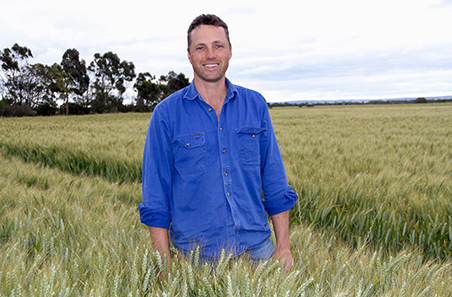
Andrew Whitlock has seen the benefits of soil testing to provide data that can inform his management decisions.

Like a winning season starts with a successful pre-season, a high-yielding, high-quality feedbase starts with paddock preparation. Get your soil into shape before the start of the season to optimise pasture and crop production.

Healthy, fertile soils drive pasture productivity and deliver environmental benefits through improved water and nutrient use with less risk of surface run-off, erosion and deep drainage.
Soil health and fertility can be broadly described as:
Optimal pasture production and environmental benefits are achieved through effective management of physical, chemical and biological soil properties.
Regular soil testing and physical inspection provides essential information to determine these management strategies.
Soils tests provide valuable information on soil nutrient levels and soil conditions that could be limiting production.
Information from soil tests can be used to develop custom management strategies and determine appropriate inputs and ameliorants to help optimise productivity, profitability and sustainability.
Red meat producers Andrew, Charles, Sam and Kirsty are using soil testing to support their management decisions and are seeing the benefits:
Andrew Whitlock has seen the benefits of soil testing to provide data that can inform his management decisions.
Sam and Kirsty White have been soil testing for almost 30 years, boosting carrying capacity by approximately 25%.
Charles Coventry began soil testing 15 years ago; growing a diverse pasture mix to increase animal weight gain.
Soil testing has enabled Don McNab to refine his fertiliser strategy and save costs while maintaining pasture productivity.
For Wimmera producers Sue and Mal Holden, strategic lime application has proven a cost-effective way to boost clover production and vigour in established pastures.
Soil testing provides useful information on soil fertility and conditions that can be used to make management decisions. Correct soil sampling techniques are important to obtain accurate results. Find out more about timing, tools and processes for soil sampling using the following resources:
This factsheet covers timing, tools and processes for soil sampling
Find laboratories accredited by the National Association of Testing Authorities (NATA)
Working with an agronomist, use your soil test results to develop a management strategy for the short and long term. Use the following resources to support your decision making:
This factsheet provides an overview of the information you’re likely to find in soil test results.
This resource provides benchmarks for common soil elements in southern Australia.
Through MLA’s Producer Demonstration Sites program, these principles were developed to assist producers in making an assessment of products on offer.
Use this as a guide to determine suitable (and cost-effective) levels of P-fertilisation through a simple five step process.
The 'Five Easy Steps' manual allows producers and advisors to understand the value of soil testing and how to use soil test information to plan fertiliser and livestock investments.
Jump on to our eLearning platform, the toolbox, where our soil testing training package will guide you through the soil testing process and the interpretation of soil test results. The toolbox provides online training, tools and resources for producers.
Signs of soil constraints are also visible from the paddock. Indicators in plants and pasture such as patchy growth, discolouration, sward composition and weed burden can be used to recognise and diagnose underlying soil problems.
Wondering what to look for?
Take a walk through the paddock with agronomist, Jess. This three-part video series covers visual indicators of soil condition in southern pastures.
Download the visual indicators of soil condition guide: available as a poster or a mobile-friendly booklet.
Jump on to our eLearning platform, the toolbox, where our training package will guide you through visual indicators of soil condition.




